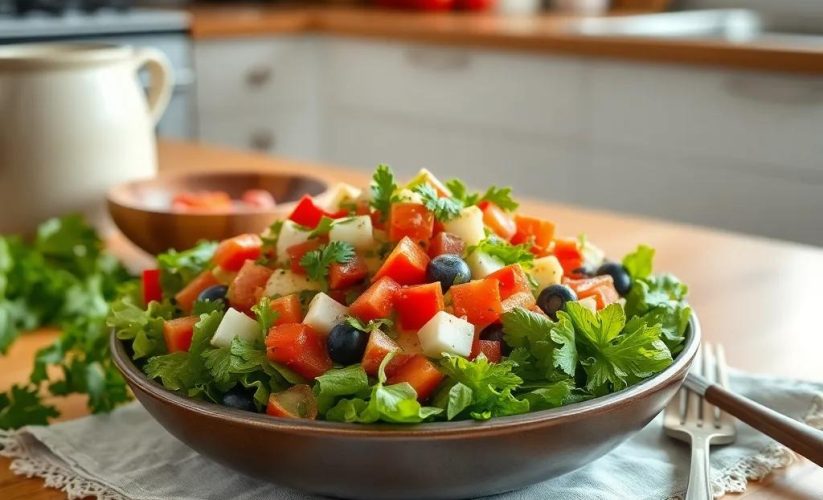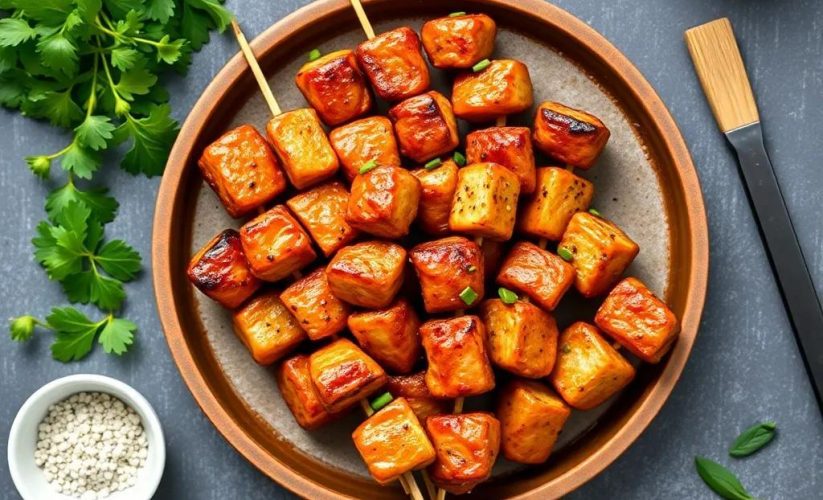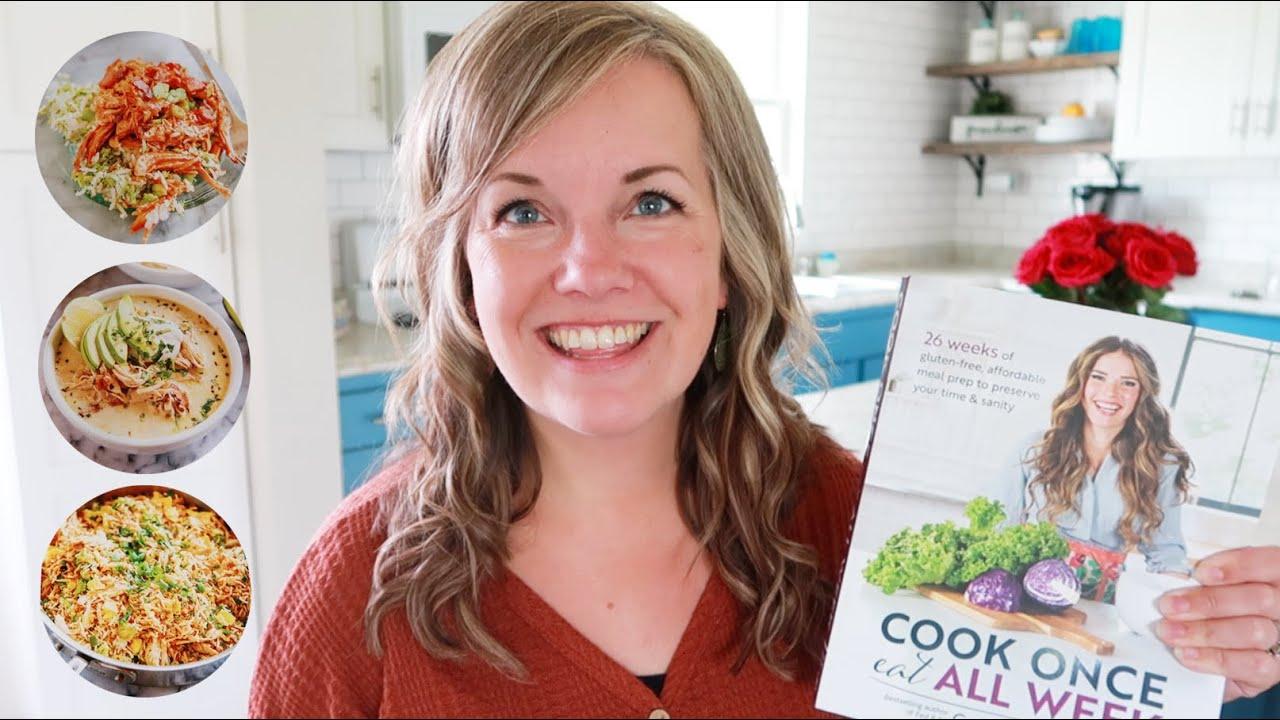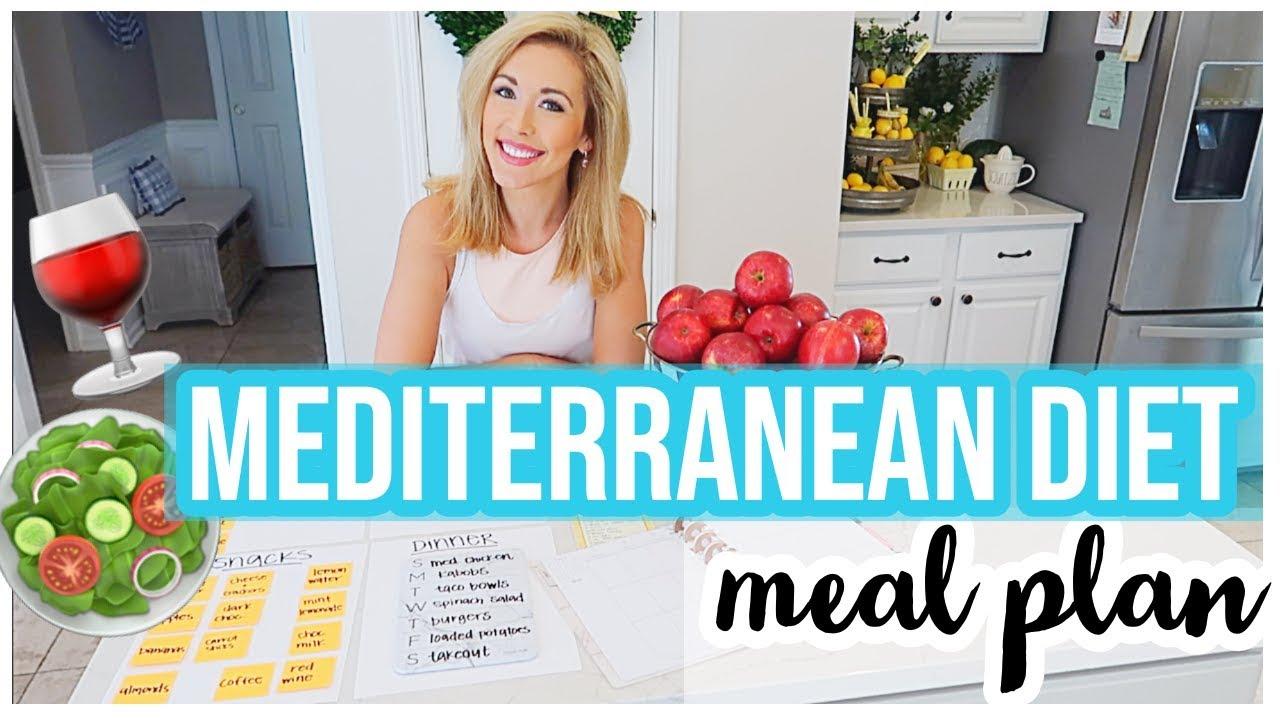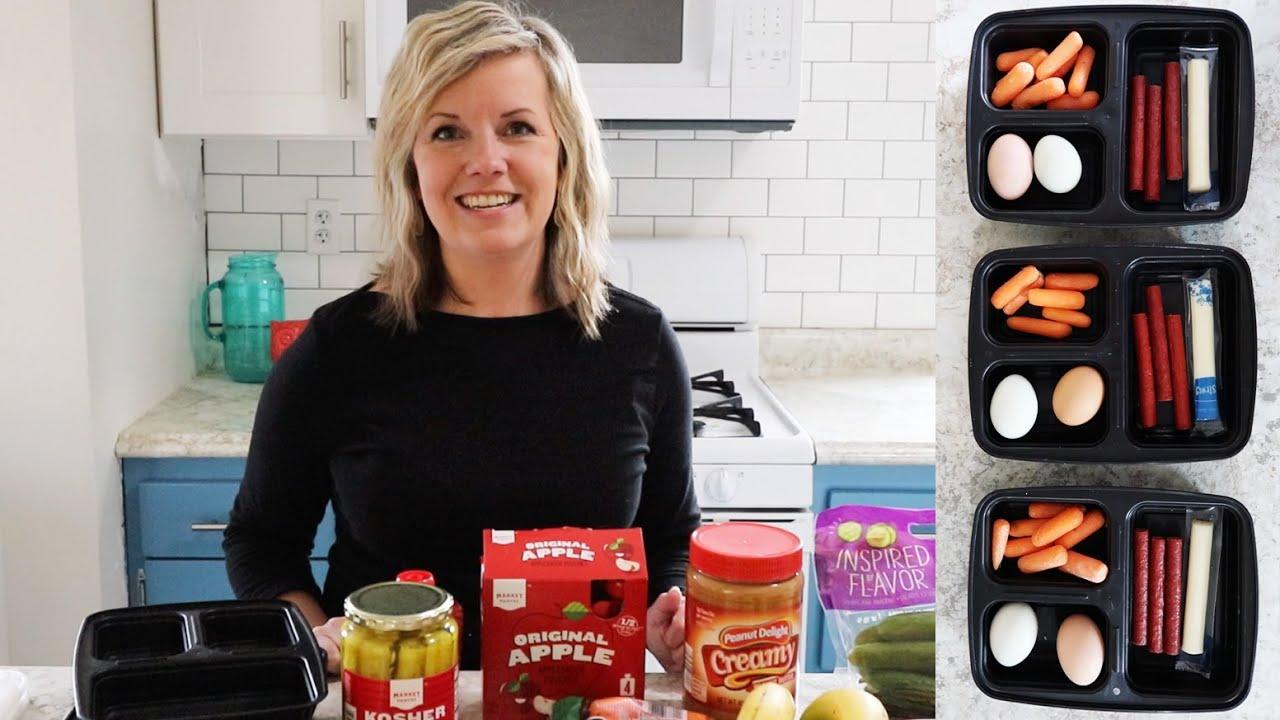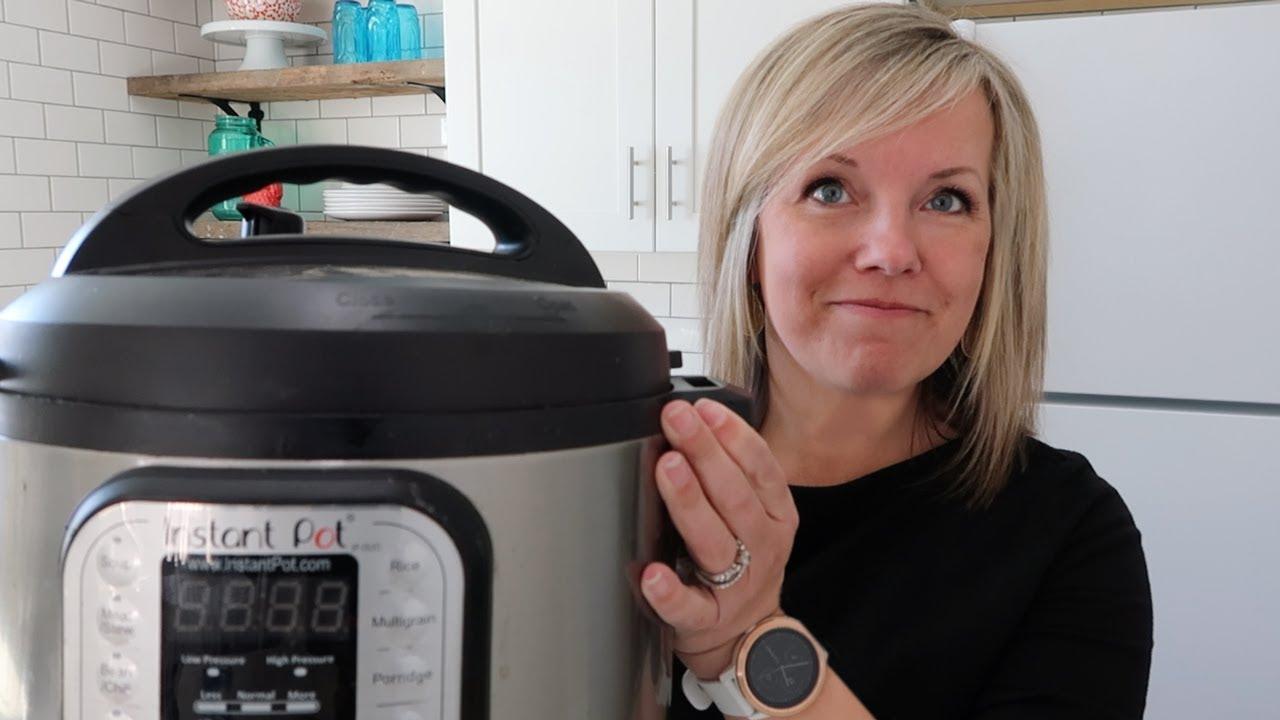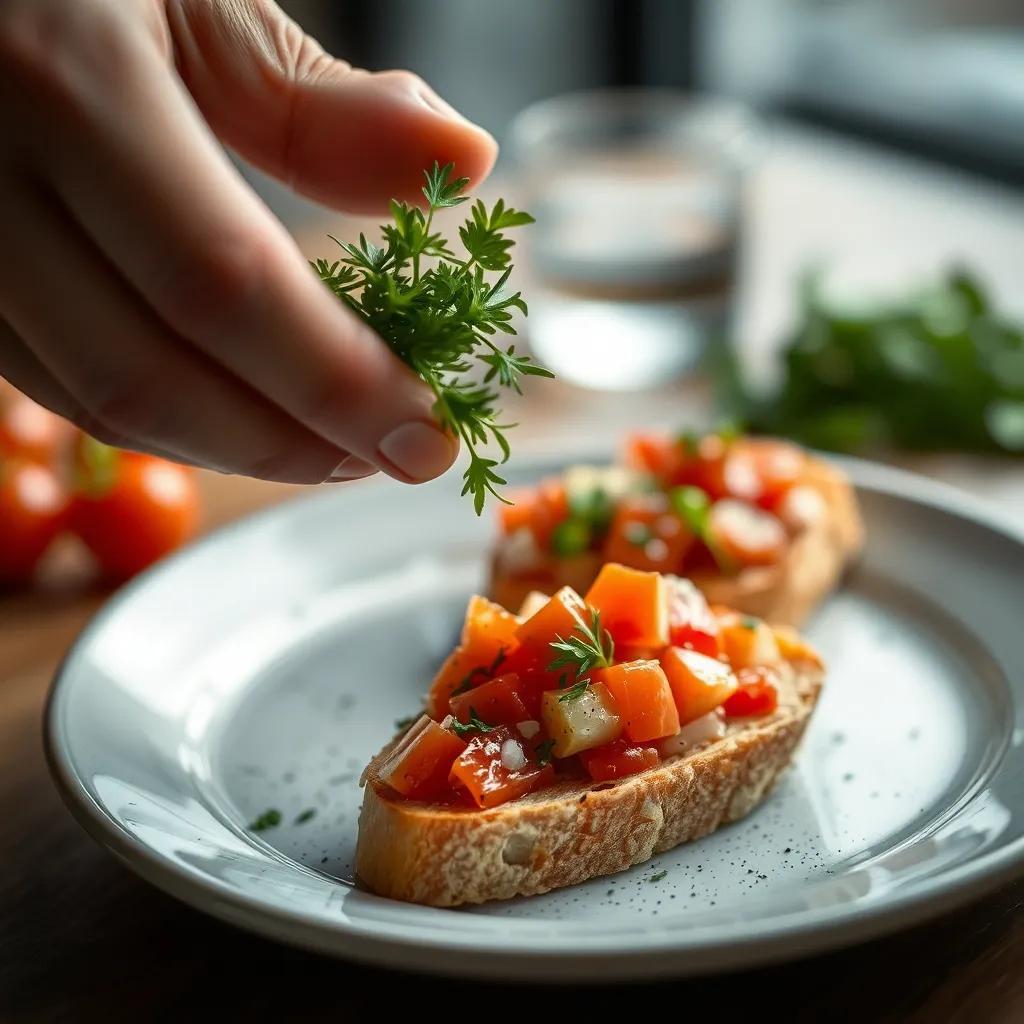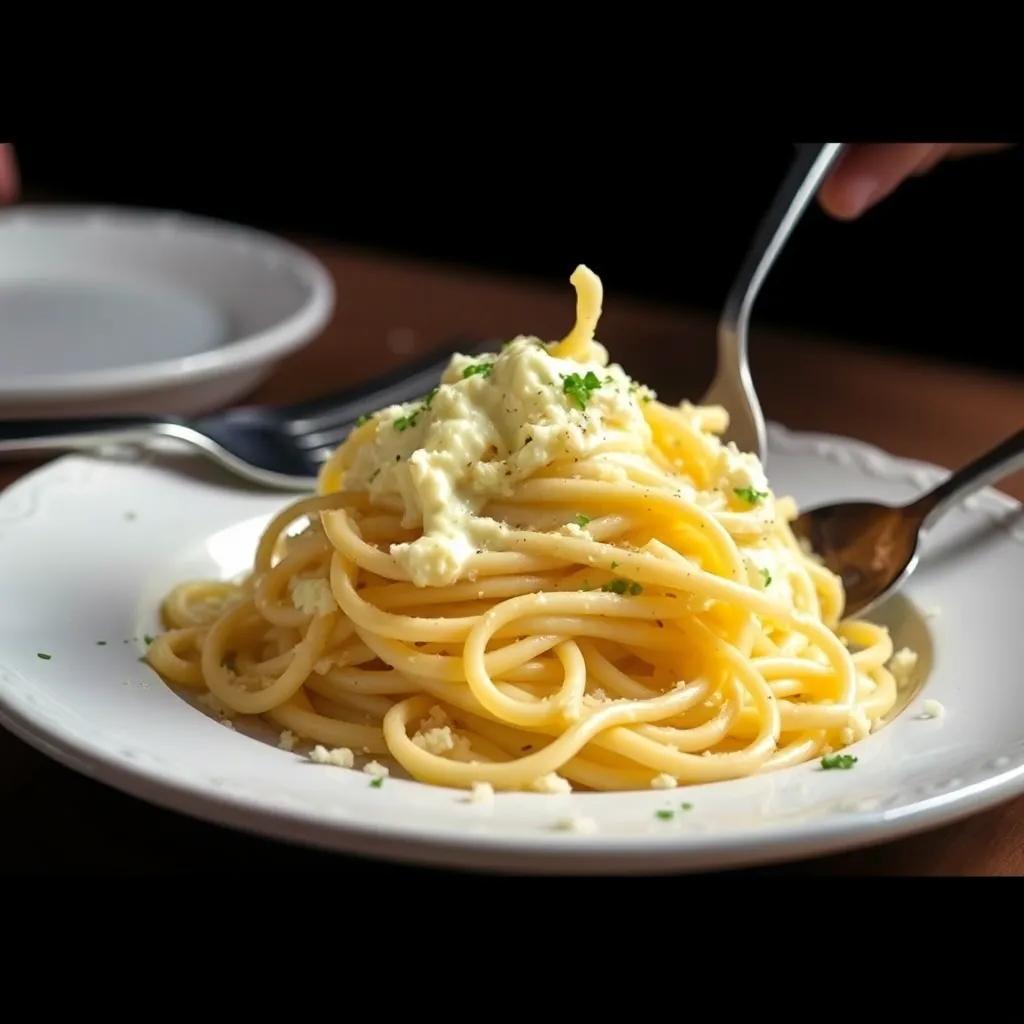Unlock Flavor: Easy 30-Minute Vegan Pesto Pasta Recipe Delight
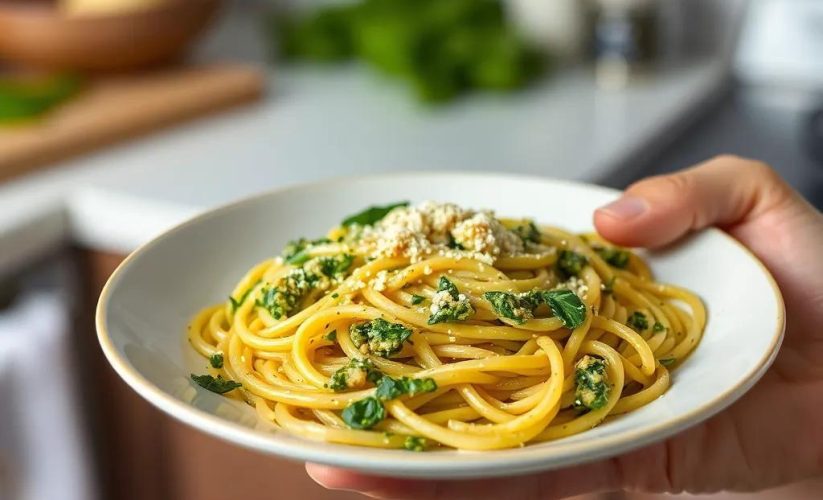
Unlock Flavor: Easy 30-Minute Vegan Pesto Pasta Recipe Delight
🌍 Cuisine: Italian
⚙️ Difficulty: Easy
Ingredients
Nutrition Facts
420
Instructions
- Bring a large pot of salted water to a boil. Add pasta and cook according to package instructions until al dente (usually 8-10 minutes).
- While pasta cooks, prepare the pesto: In a food processor, combine basil leaves, pine nuts, garlic, and nutritional yeast.
- Pulse ingredients a few times until coarsely chopped.
- With the processor running, slowly drizzle in olive oil until the pesto is smooth and creamy.
- Add lemon juice, season with salt and pepper to taste, and pulse once more to combine. Adjust seasoning if needed.
- Reserve about ½ cup of pasta cooking water, then drain the pasta.
- Return the drained pasta to the pot and toss it with the pesto, adding reserved pasta water little by little to loosen the sauce and help it coat the pasta evenly.
- Mix well until the pasta is thoroughly coated with creamy pesto.
- Optionally, stir in halved cherry tomatoes or sautéed mushrooms for extra flavor and texture.
- Serve immediately, garnished with vegan parmesan if desired, and enjoy your flavorful vegan pesto pasta!
Serving Suggestions
- Serve with a fresh green salad tossed in lemon vinaigrette for a light, balanced meal.
- Pair the pasta with crusty garlic bread or toasted baguette slices.
- Add roasted vegetables like cherry tomatoes, zucchini, or bell peppers on the side.
- Top with toasted pine nuts or walnuts for extra crunch and nutty flavor.
- Drizzle extra olive oil and sprinkle fresh basil leaves on top before serving.
- Serve chilled as a cold pasta salad for a refreshing summer dish.
- Include a side of marinated artichoke hearts or olives for Mediterranean flair.
Table of Contents
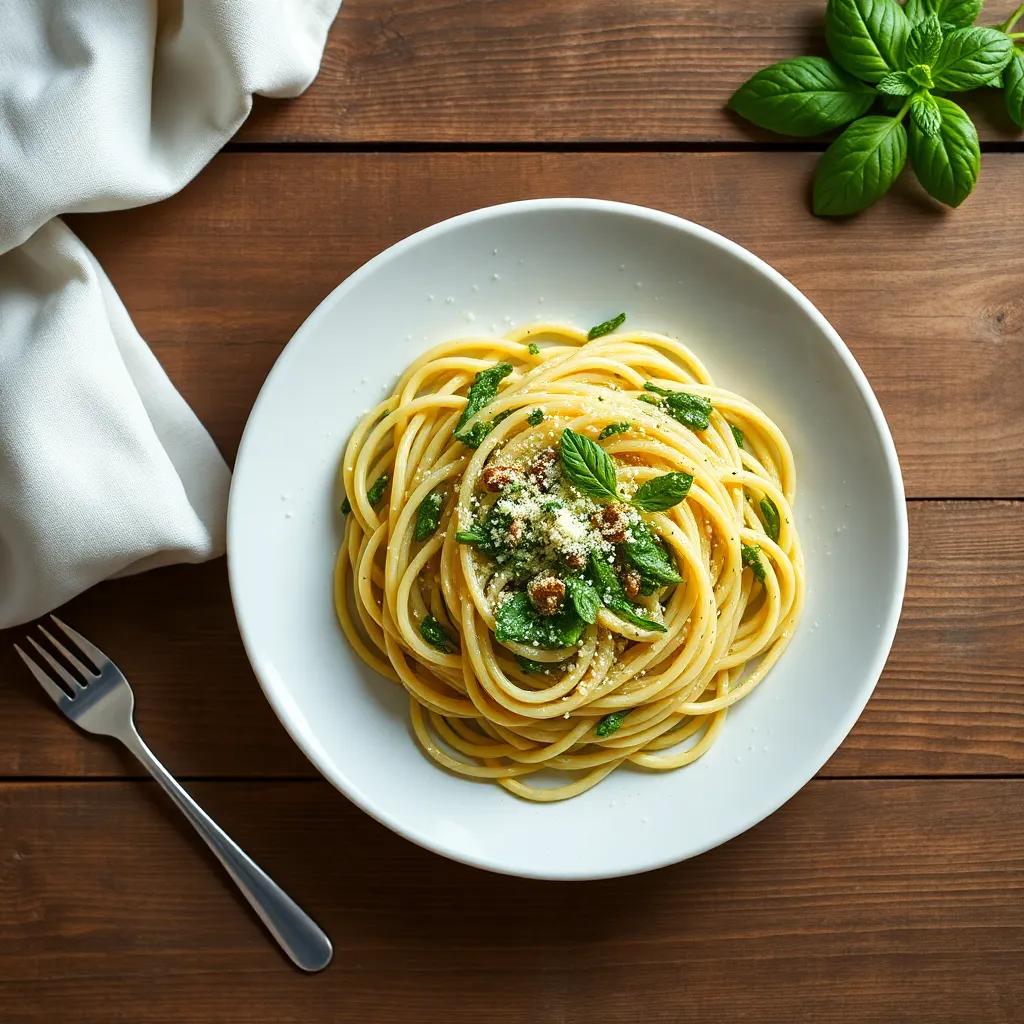
Intro
There’s something irresistibly satisfying about a dish that comes together effortlessly yet feels like a special occasion on your plate. This easy 30-minute vegan pesto pasta strikes that perfect balance between simplicity and vibrant flavor, making it a go-to recipe whether you’re whipping up a weeknight dinner or entertaining friends with a light, plant-based option. Its lush, creamy texture and fresh herbal aroma invite you to slow down and savor every bite, proving that vegan cuisine can be both nourishing and indulgent.
Ideal for busy days when time is short but you still crave a home-cooked meal, this recipe’s approachable method lets you unlock bold, authentic Italian flavors without fuss or fancy techniques. It’s also wonderfully versatile—serve it as a comforting main course, a colorful addition to a picnic basket, or a crowd-pleasing dish at your next potluck. The combination of quick preparation and satisfying taste means this vibrant pesto pasta can easily become a staple in your culinary rotation, inviting everyone at the table to enjoy something wholesome, delicious, and thoughtfully prepared.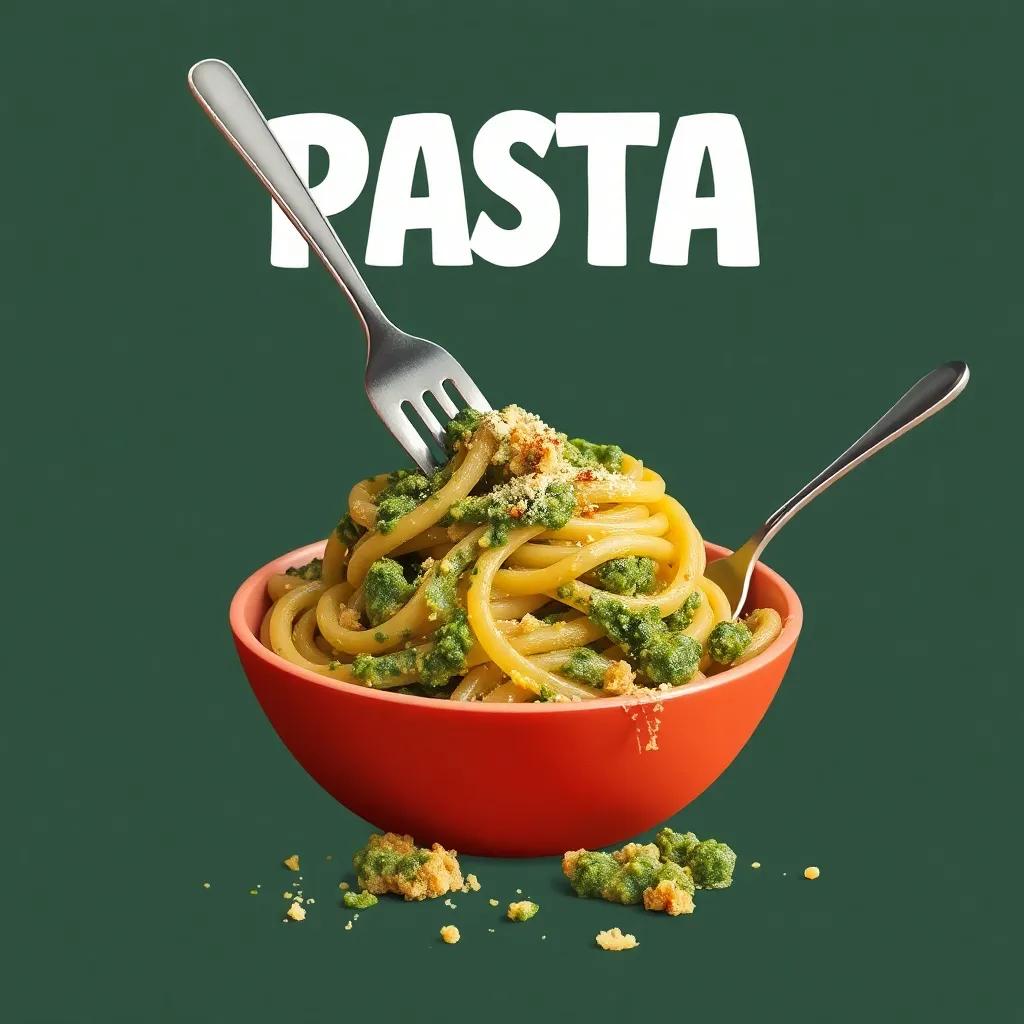
Ingredient Notes
In this vibrant vegan pesto pasta, a handful of key ingredients truly elevate the dish beyond ordinary. Let’s take a closer look at three specialties that bring this recipe to life and how you can choose or adapt them for the best results.
Fresh Basil Leaves
Basil is the fragrant heart of any pesto, and using fresh, vibrant leaves makes all the difference. Look for bright green, unblemished leaves with a strong herbal aroma—this ensures your pesto bursts with that unmistakable sweet and slightly peppery character. When buying, opt for basil from local farmers’ markets or organic stores when possible, as fresher leaves yield more intense flavor than mass-produced supermarket bunches. If fresh basil isn’t available, frozen basil can work in a pinch, though it won’t have quite the same bright fragrance or texture.
Pine Nuts (or Walnuts)
Traditionally, pine nuts bring a rich, slightly buttery depth to pesto, contributing to its creamy texture and nutty flavor. However, they can be pricey or sometimes hard to find. Walnuts offer a fantastic, budget-friendly alternative with a pleasantly earthy note and a bit more texture. Toasting either nut lightly before blending enhances their flavor and adds warmth—with walnuts benefiting especially from this step. For those with nut allergies, roasted pumpkin seeds or sunflower seeds can be creative substitutes, providing a similar crunch and subtle nuttiness.
Nutritional Yeast
In place of parmesan cheese, nutritional yeast is the secret to achieving that savory, cheesy umami flavor that makes this pesto deeply satisfying and authentically Italian in spirit—while keeping it fully vegan. When selecting nutritional yeast, go for the flakes rather than powders, as they blend more evenly and deliver a fuller taste. High-quality brands often also add extra B vitamins, making this ingredient both tasty and nutritiously beneficial. If you don’t have nutritional yeast on hand, a splash of miso paste or a pinch of smoked paprika can add complexity, though the flavor will differ from the classic cheesy notes.
By choosing these ingredients thoughtfully—and knowing when and how to swap them—you set the stage for a luscious, bright pesto pasta that feels both indulgent and wholesome, all in just 30 minutes.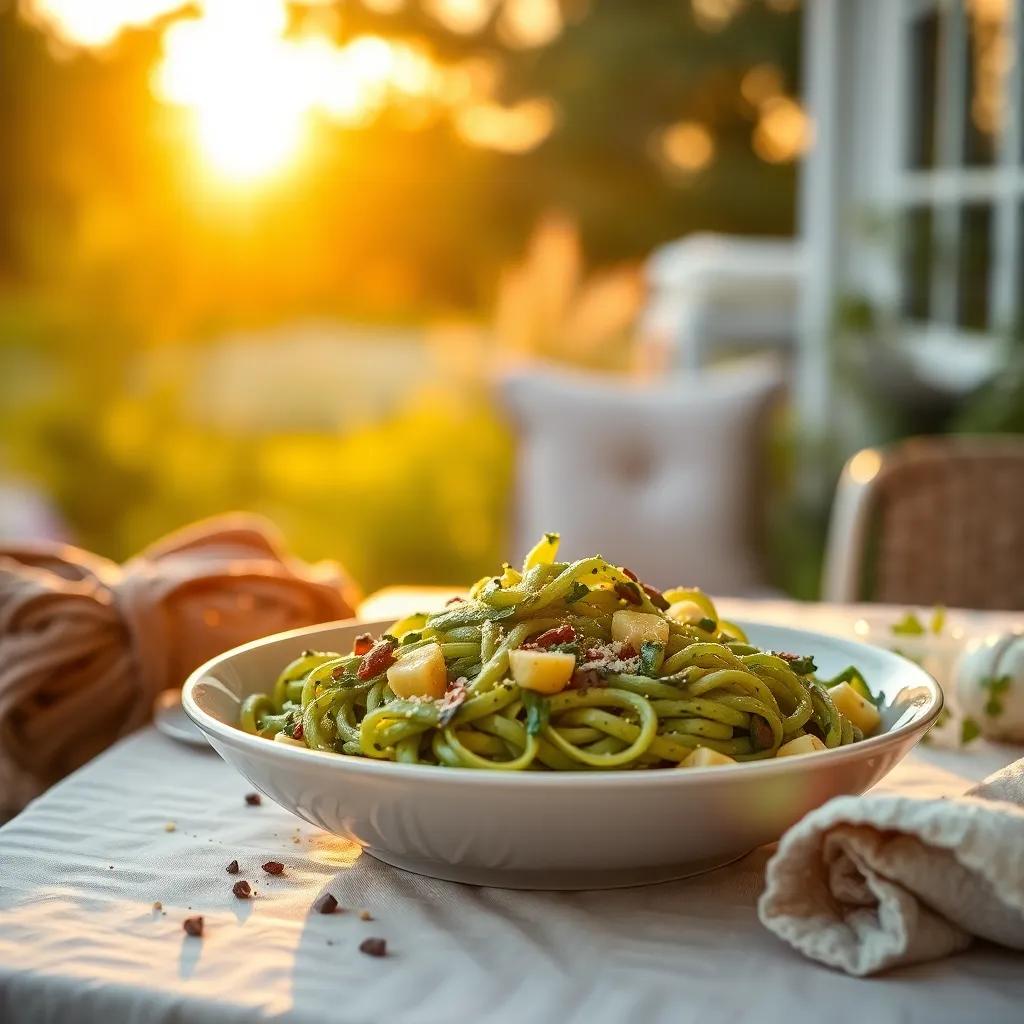
Tips & Variations
To elevate your vegan pesto pasta experience and make the recipe truly your own, consider these tips and variations that add flair, accommodate dietary preferences, and boost flavor depth:
- Perfecting the Pesto Texture: If you find your pesto too thick or pasty, gradually add more reserved pasta water or olive oil, a tablespoon at a time, until you achieve a luscious, silky consistency that clings beautifully to each strand of pasta. For an extra creamy finish, try blending in a small handful of silken tofu or soaked cashews—both add richness and smoothness without overpowering the bright basil notes.
- Customize Your Greens: While fresh basil is classic, feel free to experiment by swapping half or all of it for other leafy greens like spinach, arugula, or baby kale. Arugula, for instance, introduces a pleasantly peppery bite that brings complexity, while spinach lends mild earthiness and boosts the nutrient profile without muting the basil flavor.
- Nut & Seed Swaps for Allergy-Friendly Options: Pine nuts and walnuts are traditional, but for those with allergies, shelled pumpkin seeds or hulled sunflower seeds make excellent, allergy-safe alternatives. Toast them lightly first to unlock their nutty aromas. Alternatively, hemp seeds not only provide a subtle nuttiness but also contribute healthy omega-3s for a nutritional boost.
- Garlic Intensity and Flavor Boosters: Adjust the garlic quantity based on your preferences—skip a clove for milder pesto or add an extra clove or roasted garlic for deeper savoriness. Roasting garlic before adding it to the pesto adds a sweet, mellow dimension that transforms the flavor profile into something more nuanced and rich.
- Zesty Twist with Citrus: Aside from the lemon juice in the recipe, try adding a touch of lemon zest or swapping lemon for lime juice for a fresh, tangy variation. Orange zest can usher in a subtle sweetness, especially when paired with cherry tomatoes or sautéed mushrooms, enhancing the overall brightness.
- Pasta Choice and Gluten-Free Options: While penne, fusilli, or spaghetti are ideal for holding the pesto, this dish is versatile with any pasta shape you have on hand. To keep it gluten-free, simply use your favorite gluten-free pasta made from rice, corn, or chickpeas. Chickpea pasta, in particular, adds extra protein and a lovely texture that complements the creamy pesto beautifully.
- Add-Ins for Texture and Flavor: Incorporate sun-dried tomatoes, toasted breadcrumbs, or kalamata olives to introduce bursts of richness and savory contrasts. For a warming note, sprinkle a pinch of red pepper flakes into the pesto or as a final garnish—perfect for those who like a gentle kick.
- Serving Variations: This pesto pasta can also shine as a cold pasta salad. Just toss cooked and cooled pasta with the pesto and add crisp vegetables like cucumbers, bell peppers, and fresh herbs. It’s a refreshing way to enjoy it during warmer months or as a grab-and-go lunch option.
- Boosting Protein Content: To make this meal more substantial, toss in cooked chickpeas, sautéed tofu cubes, or roasted tempeh. These plant-based proteins blend seamlessly with the pesto and pasta and make it even more satisfying as a complete meal.
These thoughtful tweaks and substitutions not only help you tailor the recipe to your pantry and palate, but they also invite you to explore your creativity in cooking while keeping that classic Italian spirit alive. Whether simplifying for dietary needs or elevating for special occasions, your vegan pesto pasta can be as versatile as it is delicious.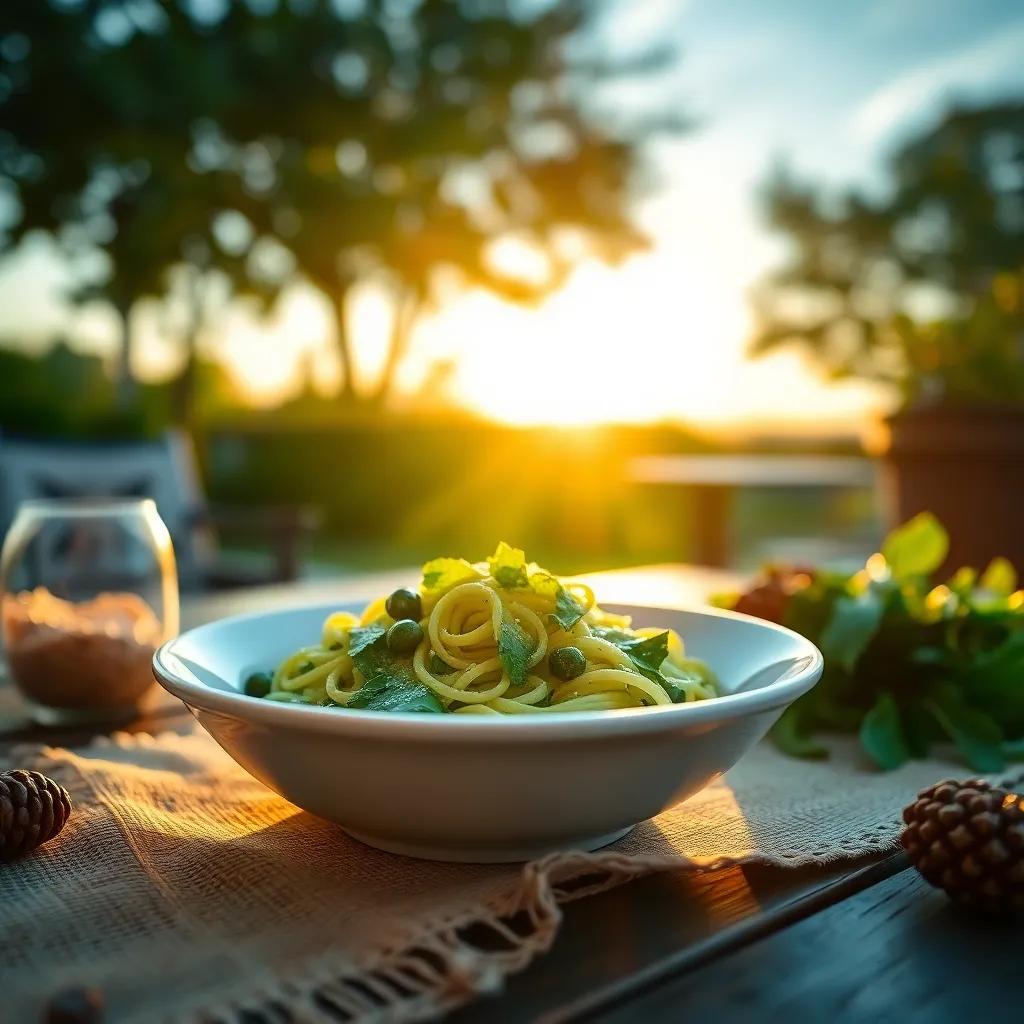
Leftovers & Storage
After enjoying your vibrant vegan pesto pasta, storing any leftovers properly ensures you can savor its fresh flavor and creamy texture again with ease. To keep your pesto pasta tasting its best, transfer leftovers into an airtight container once cooled to room temperature. Glass containers with tight-fitting lids work wonderfully here—they won’t absorb odors and are easy to reheat without affecting the dish’s delicate flavors.
In the refrigerator, your pesto pasta will stay fresh for up to 3 to 4 days. For optimal texture, avoid storing the pasta with the pesto sauce mixed in if you plan to reheat later; instead, keep the cooked pasta and pesto separate when possible. This helps maintain the pesto’s bright herbal notes and prevents the sauce from turning overly oily or dull after chilling. When ready to eat, gently reheat the pasta in a skillet over low heat with a splash of water or reserved pasta water to revive that luscious creaminess.
If you want to keep your delightful meal on hand longer, you can freeze the pesto sauce alone (without the pasta) for up to 2 months. Use freezer-safe containers or silicone ice cube trays for portioned servings—perfect for quick weeknight dinners when time is tight. Thaw overnight in the fridge and stir well before tossing with freshly cooked pasta.
For packed lunches or meal prep, this pasta shines as a make-ahead favorite. Keep pesto and pasta separate in portioned containers, adding any optional toppings like cherry tomatoes or vegan parmesan just before serving to preserve freshness. The vibrant colors and fragrant basil won’t just taste fresh—they’ll brighten up your midday meal.
By following these simple storage tips, your easy 30-minute vegan pesto pasta can continue to inspire your meals beyond the first serving—saving you time in the kitchen while treating your taste buds to that unmistakable fresh, herbaceous flavor every time.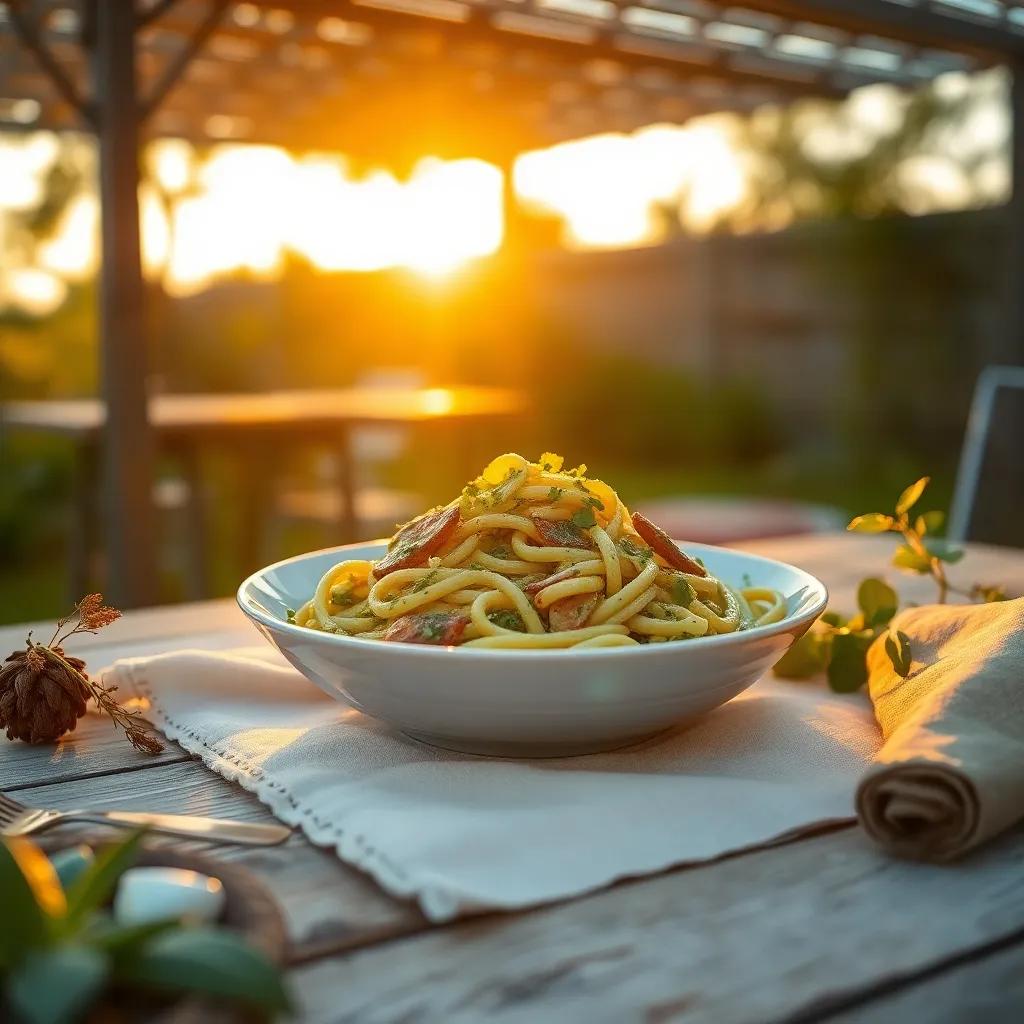
Behind the Recipe
Pesto pasta is a dish steeped in Italian tradition, originating from the Liguria region along the Italian Riviera. The word “pesto” comes from the Italian verb pestare, meaning “to crush” or “to pound,” a nod to the original method of creating the sauce by grinding fresh basil, nuts, garlic, and cheese with a mortar and pestle. This recipe honors that heritage yet reimagines it through a vegan lens—swapping traditional parmesan for nutritional yeast and olive oil as the luscious binder—making it accessible to those seeking plant-based comfort without compromising on authenticity.
The inspiration behind this easy 30-minute vegan pesto pasta came from a desire to simplify a classic without losing its soul. After experimenting with various versions, it became clear that freshness, quality ingredients, and a few mindful tweaks could unlock vibrant flavors while accommodating a modern, conscious lifestyle. The quick preparation time was intentional—to embrace the spirit of Italian cooking, where simplicity meets the rhythm of everyday life and where meals are crafted with care but never complexity.
This dish also embodies a personal story: a beloved staple in my own kitchen that bridges cultural appreciation and sustainable eating. It’s the go-to solution for busy evenings, a favorite to share with friends unfamiliar with vegan food, and a reminder that timeless recipes can evolve gracefully while retaining their heart. Each bite expresses a connection to tradition, community, and the joy of wholesome ingredients working harmoniously—a celebration of culinary heritage that’s approachable, inclusive, and utterly satisfying.
FAQ
Can I use a different type of pasta for this vegan pesto pasta?
What can I use instead of pine nuts in the pesto?
How can I store leftover pesto pasta, and will it keep well?
Is there a way to make this pesto pasta nut-free?
Can I prepare the pesto sauce ahead of time?
How can I add more protein to this vegan pesto pasta?
Can I freeze the pesto sauce or pesto pasta for later use?
Enjoy Your Meal!
In just 30 minutes, this vibrant vegan pesto pasta brings fresh, bold flavors to your table without any fuss—proving that plant-based cooking can be both simple and delicious. Whether you’re new to vegan dishes or a seasoned pro, this recipe is a delightful way to unlock something fresh and wholesome in your weeknight meals.
We’d love to hear how your pesto pasta adventure turns out! Feel free to leave a comment, share your rating, or add your own personal twist to the recipe. After all, the best dishes are the ones we make our own—so happy cooking and enjoy every flavorful bite!

